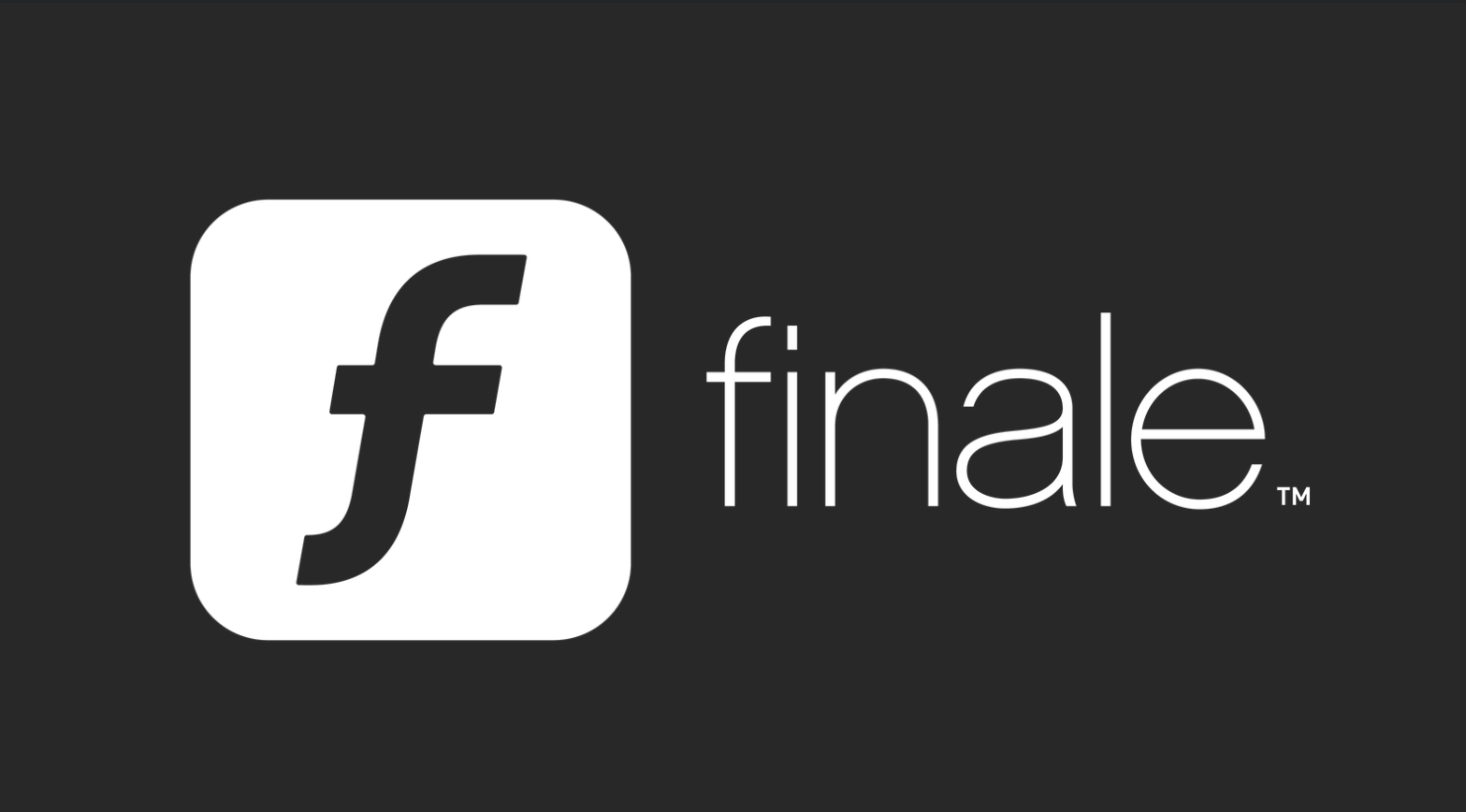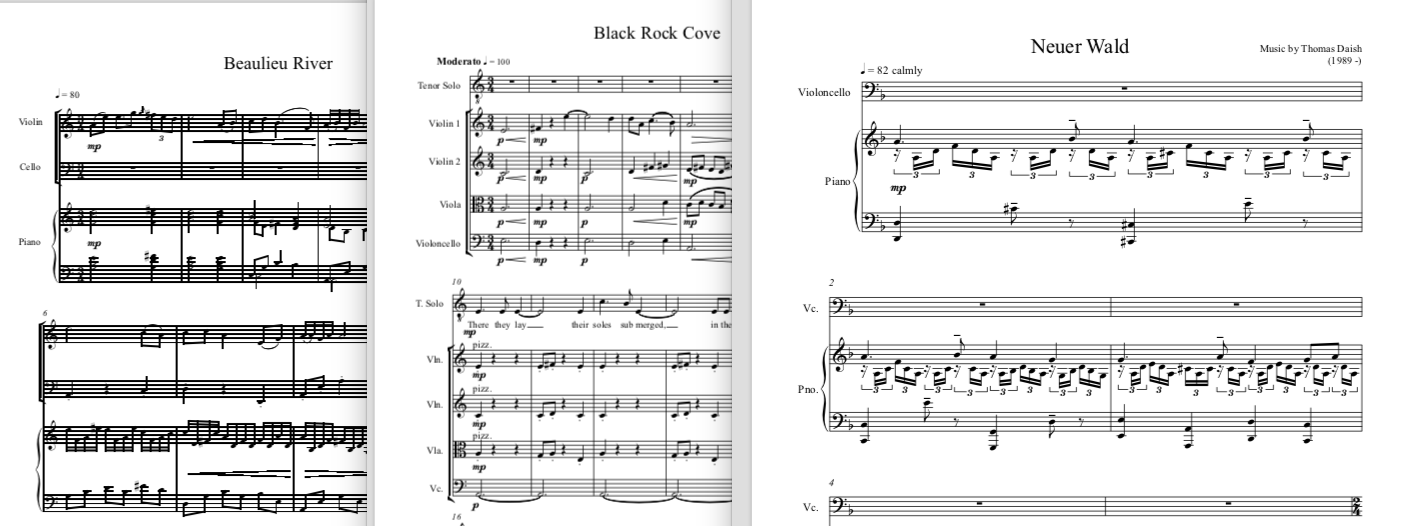Switching to Finale V27 (after 25 years using Sibelius software)
Having used Sibelius notation software for about 25 years, the idea of switching to an alternative platform would normally be considered unthinkable… times change.
After updating my Mac’s operating system to ‘Big Sur’, I discovered my perpetual Sibelius 7.5. licence had been rendered quite useless. Although the software itself can install and boot in Big Sur, the standalone application which verifies the product licence code is not actually compatible, thereby limiting usage to that of expired trial access features. Furthermore, Avid now consider anything below Sibelius ultimate as ‘legacy software’ and as such it is very unlikely they’ll ever do anything to remedy this issue for Mac users. I feel very bitter about the idea of sacrificing my “perpetual licence” for Avid’s subscription package and feel motivated to look elsewhere, or in the worst case, switch to Windows.
I reviewed both Finale Notepad and Garritan Person Orchestra on behalf of ‘Techstrike UK’ back in 2012. My initial thoughts of both products were resoundingly positive, although at the time I was cautious of the inevitably steep learning curve adopting a new notation platform would demand.
Nine years on, I have just installed a fresh copy of Finale (v27) on my Mac and am very grateful to the team at Makemusic for making this article possible.
Please consider this article my first impressions of Finale in 2021 – I will definitely need to revisit and update my post as I become more fluent with the software. Although it will most likely take months, if not years, to gain a similar degree of fluency with Finale as I have with Sibelius, there are several tasks that Finale quite noticeably does very well, which will assist readers thinking of transitioning between platforms:
XML Score Imports
Although not an exclusive feature to Finale, the XML score import function offers a lifeline when transferring Sibelius files from their bespoke .sib format and I have begun the lengthy process of converting over two decades of .sib files to xml so they are not lost to history.
XML files import surprisingly well into Finale – as can be seen from figs A and B below – with only slight formatting and text alignment hiccups which are very easily and quickly remedied.
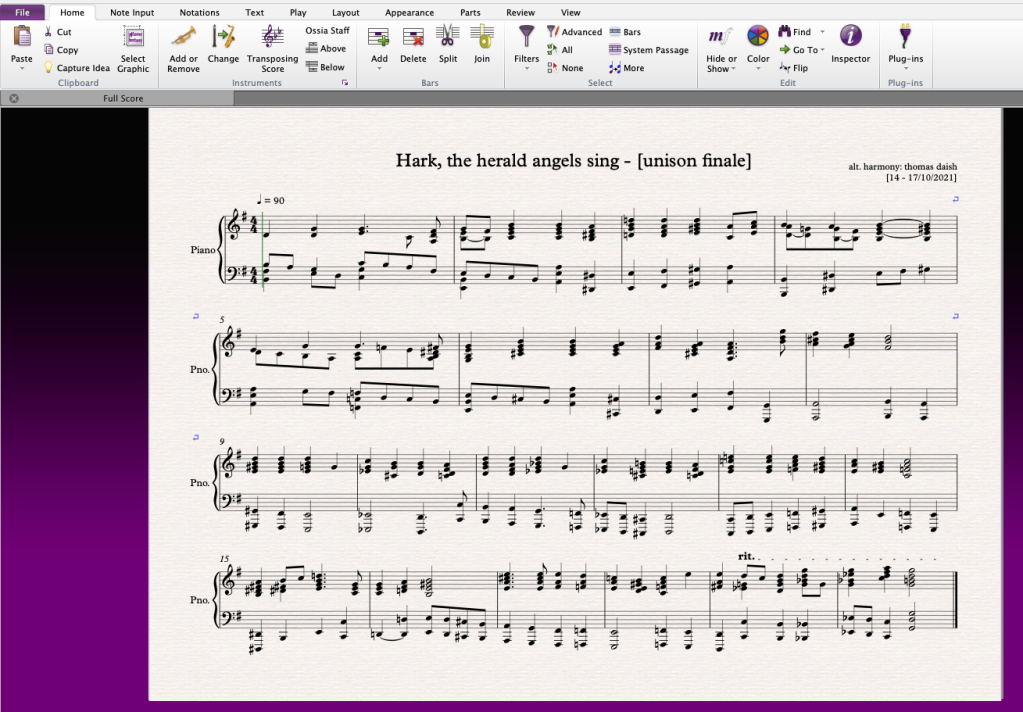

Audio Units / Banks / Effects
Although Finale’s own sound banks are absolutely fit for purpose when demoing a score. I am already growing very fond of the setup page for AU, banks and effects. Sibelius does offer similar functionality, however I found Finale’s setup to be both concise and intuitive. I was able to calibrate score playback within seconds.

Document setup
Although this may seem like a very simple feature, it is something I’ve never noticed when using my previous version of Sibelius – customisable ensemble selection when using the new document setup wizard. I often write several pieces for the same people in the same ensembles. Finale’s feature makes repetitive score setup much more efficient and allows a little more time and space to hit the ground running on new projects.
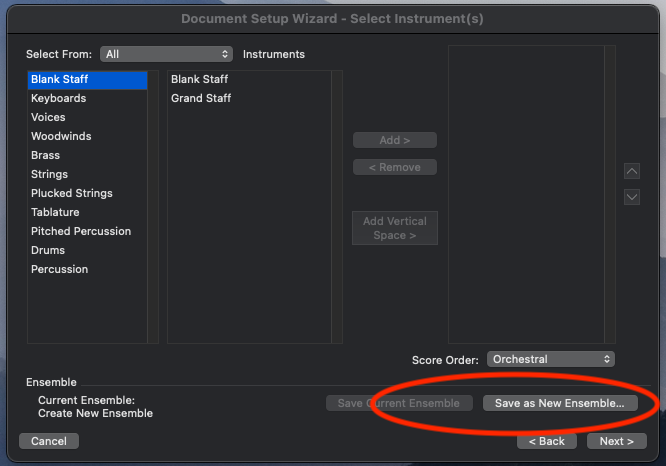
Demo Project
I decided to write a short passage to offer a cross-comparison between Finale and Sibelius.
Although the passage below is relatively short and simple, it features; multiple time signature changes, frequent switching between triplets and standard notation, repetition, ties, symbols and augmentation as well as cosmetic elements such as notehead colouring and automatic text alignment.

The excerpt above was produced in under a minute using Sibelius. However, it would be unfair to judge my experience based on speed alone as I am still new to Finale. After following a few online tutorials, I quickly got the hang of Finale’s UI and put the second score together (below) in about 10 minutes. Although it is not a 100% accurate re-creation (I still don’t have the proficiency to deal with notehead colorings, removing the unintentional extra tie at the end of bar 4 or adding symbols), I was still very pleased with the results of this early attempt.

Software boot time
A very quick point here, but I was blown away by how quick it is to install and boot Finale from scratch. Regular boot time to the setup wizard is a matter of seconds, lightyears ahead of my experiences with Sibelius.
All of that said, I do have a few minor reservations…
Input / Note selection
This is an entirely subjective, stylistic preference but I am not a fan of Finale’s non-visual num pad integration. As can be seen below, Sibelius offers a really intuitive keypad solution which aligns almost perfectly with the num pad on most mechanical keyboards. Although rather simple, the Sibelius keypad really does help to streamline the whole writing process and I absolutely love the ability to see the note voicing I am using on the fly.

Num pad functionality is available in Finale and (if you have the time) can be individually hotkeyed, but to the best of my knowledge, Finale does not offer a comparable visual solution to Sibelius. At the time of writing, I cannot find a similar graphical representation of the num pad. In short, begrudingly I am going to have to take the time to memorise and get used to a slightly different layout in Finale, although I’m sure it’ll be worth the effort.
Again, perhaps an unfairly subjective critique – I am still inexperienced and still coming to terms with notation input on Finale. For a long-time Sibelius user, the input process may seem unnecessarily slow and bumpy – for example, selecting an individual note on a score doesn’t seem to be as simple as left clicking on the note with a mouse. I am reluctant to be too harsh at this early stage though and will certainly be happy to revisit my comments once I become more familiar with the software and shortcuts in a few months time.
All in all…
To the uninitiated, switching to Finale is not without caveats; the UI and contrasting hotkeys will feel alien and, be under no illusion, the software comes with a steep learning curve for those better used to other platforms.
That said, Finale does really well at accommodating a lot of the needs a migrating Sibelius user may have. In particular, its efficient boot, document and audio playback setup sequences as well as surprisingly clean xml integration will be a big plus for many, myself included. I hope to revisit this article after I’ve had a few months with the software but overall, my first impressions are very positive indeed.
Clocking Out – [a brief commentary]
Clocking Out is a short A-B binary form jazz sketch, featuring live improvised solos on both the piano and overdriven clavinet (with manual wah via a mod wheel). An mp3 download is available to visitors of my BMC profile [clicking here will redirect to the BMC profile on a separate browser window] and it can also be viewed on YouTube from April 16th, 2021.
Clocking Out adopts some stylistic elements from recent tracks posted on YouTube but is not thematically connected and stands on its own. The track is a fusion of influences from my ‘recreational music playlist’, including references to: Steve Vai (building the church), Jeff Beck (blast from the east), Mark Knopfler (private investigations) and generally nods to the music of Jordan Rudess and Joe Satriani.
The introduction [fig. A below] features a looped passage using a Kora [which was the closest artificial sound I could get to a ‘shamisen’ on my edition of NI Komplete]. The passage is doubled by the bass guitar and looped throughout the introduction. The keyboard line was recorded on a Scarbee A-200 using NI Komplete, via Logic. The subdued walking-pace rhythm gives the sensation of seconds passing by whilst the faster juxtaposed kora and bass lines give a sense of urgency and continuation. Essentially, the clock is ticking!
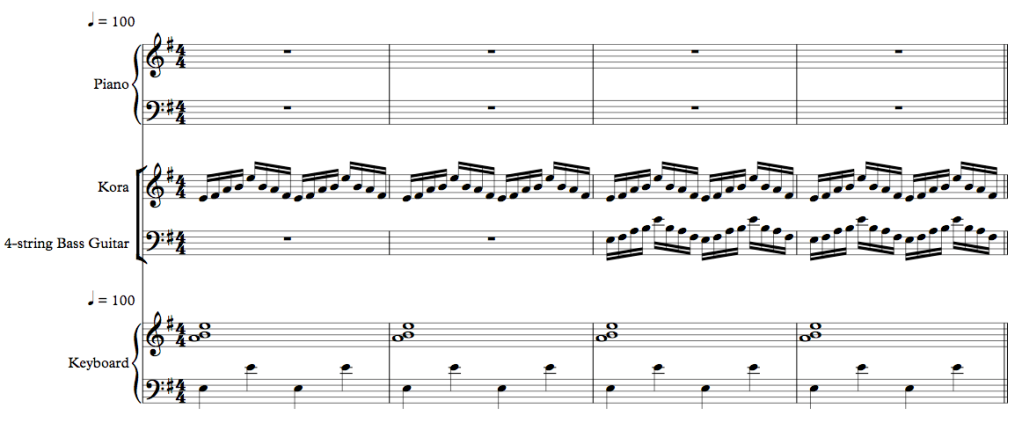
Bar 5 [fig. B] sees the introduction of a syncopated piano backing. Despite the backing of the passage being somewhat repetitious, the piano’s rhythmic syncopation and harmonic dissonance enables variety and suspense while building towards the introduction of the improvised solo passages.

The backing from bar 15 [fig. C] is reduced to just the piano, bass and drums. This enables enough room for improvised instrumental solos from both a solo piano and an overdriven clavinet. This was my first attempt at recording a clavinet using manual wah via a mod wheel – it took some getting used to as the sustain pedal (a more natural application for wah) would cut the tone and I was reliant on using the mod wheel during rapid passages but I am happy with the overall effect.

After the first round of solos, the music returns to it’s A-theme, building towards a second round of live solos which feature arpeggiations, cross-handed playing in the piano line and again frequent wah manipulation using the mod-wheel.
The relatively straightforward AB structure and notated figures in this commentary should help in setting up your own backing if you want to try the track out for yourself. It was good fun to improvise over!
Room With A View – [A Brief Commentary]
Room With A View is the first of an ongoing series of sketches, which I hope to update and expand on periodically during my time living in Japan. The first is set to a personal video I took whilst visiting the Tokyo Metropolitan Government Building in the spring of 2019. It took 2 years to get around to it, but I’ve finally found a moment to set it to music.
At the time, my Japanese was limited to just a few short sentences – yet I was confronted by this expansive view of the city from the top of the government building. It was like staring at an overwhelming moment of opportunity, which, by my own fault, I was hopelessly prepared to take on at the time.
One of my first impressions of the video is the striking sense of humidity suggested by the reflections of sunlight on the glass. To capture that sense of warmth the track begins with low Amin7, Cmaj#7, Amin7, Cmaj#7+9 chords, which are looped using a warm synth pad preset. See. Fig. A below

The 5th bar sees the introduction of the first core melody, played on the piano. The part intentionally features with a wide gap between the left and right hands [see fig. B below] with the right hand intervals narrowing towards the ends of each phrase – this is essentially a musical representation of observing the picture as a whole before focusing on its finer details. There’s quite a lot to see and the video slowly zooms during playback, so time is hopelessly limited – you’ll never take in everything.

The first half is rounded off with the introduction of the 2nd core melody, played on the Shakuhachi. The melody is performed at discretion of a vst instrument, given I don’t know any Shakuhachi players and the melody itself exceeds the limits of the instrument as can be seen in fig. C below.

The 2nd half of the sketch essentially features a texture build with layered improvisations before a deconstruction of the texture and a concluding drop in tempo.
Any proceeds generously sent to my Buy Me Coffee profile will be used towards transport/ticket costs for future videos in this series. I already have footage from Hamamatsu’s Act Tower to work with but I hope to shoot future videos in Fuji, Nagoya, Osaka, Kyoto and Sapporo as soon as it is safe to travel between prefectures.
Home Liner – [a brief commentary]
Home Liner is the latter of three short sketches uploaded to YouTube during the first week of April 2021. The track concludes my theme of Japanese transportation, this time paying homage to a private rail service for commuters called ‘The Home Liner’.
The Home Liner is essentially a private commuter train, which charges a measly additional 300JPY (roughly £2/$3) ontop of the regular destination charge for JR customers. However, that additional price offers the passenger a usually near-empty train carriage, a guaranteed seat, ample leg room, limited stops and the chance to relax during a commute. It’s a tranquil and meditative contrast to the usually busy and uncomfortable carriages provided on the regular JR line.
Today’s track again references the previously mentioned Uehara, Inaizumi and Suzue but also touches on several surprising central European influences.
The opening segment (see fig A. below) repeats multiple times throughout the track and was heavily inspired by the meditative music of French Christian Taizé worship from the 1940s.

Akin to Taizé music, my track achieves variety by building in texture (as can be seen with the introduction of keys, drums and bass in fig. B) however, I deviate from standard Taizé form by creating continuity through dissonance – in this case, by using a lot of chromatic movement which is easily noticeable in the bass line as well as the backing harmony. Overall, the music, by design, feels irresolute and necessitates a slow sense of movement, much like the slow and peaceful night train I was writing about.

The majority of the upper line is improvised with the exception of the core melody, which is introduced in fig. C below. This core melody acts as an anchor at the beginning and also during an irresolute transition mid-way through the track, pulling the music on, like a train does its carriage.

Takushī! – [a brief commentary]
click here to listen to Takushī! – [redirects to YouTube in a separate window]
Takushī! Is the second of three short sketches uploaded to YouTube during the first week of April 2021. It continues the theme of Japanese transportation, this time alluding to the taxi drivers of Kakegawa city, near Hamamatsu.
As before, the music gives respectful nods to Uehara Hiromi, her group ‘Sonicbloom’, as well as the artist Inaizumi Lyn and producer Suzue Machiko.
This time however, I altered the instrumentation slightly to afford a NI Komplete 11 Scarbee A200 keyboard solo, using the preset ‘Breakfast in America’ – thereby combining the Japanese influences with (at least) the keyboard sound of Supertramp(!) who I enjoy listening to on a regular basis.
Although the track itself in A Major, it is dissonant throughout to provoke continuation. For example, the music incorporates frequent use of flattened 6th and 7th degrees throughout the introduction as can be seen in fig. A below.

Takushi! also midly references Tokaido Time, in the sense that again there is harmonic substitution juxtaposed with a consistent pedal note in this case, G natural. Basically, each chord is similar but changes slightly! Afterall, not every Taxi you get into is exactly the same!
Bar 10 sees the introduction of the melody (see fig.B below) which was doubled in octaves for the recording. However, it could be played without doubling using just the right hand and the looped backing in the left hand if there were only 1 keyboard player in a live scenario.

The backing loops again after the tune’s exposition and the texture reduces to a solitary piano improvisation ontop of the bass and drums. There is an exchange with the so-called ‘Breakfast in America’ Scarbee A200 which leads to a scalic bridge session and finally a recapitulation of the original theme. The Scarbee A200 rounds off the track with some warm chording. I deliberately close the track on the subdominant (D Major) to allude to the final movement, “Home Liner” which will be uploaded in the near future.
Tokaido Time – [a brief commentary]
Click here to listen to ‘Tokaido Time’ – [redirects to YouTube in a separate window]
‘Tokaido Time’ is the first in a series of three short sketches uploaded to YouTube in April 2021. It is loosely based on my experience of local railway line, the Tokaido line, which connects the city of Hamamatsu as far north as Atami.
The sketch nods heavily towards the works of Uehara Hiromi, an internationally renowned jazz pianist who originates from Hamamatsu city, where I currently live.
The sketch was also influenced by the work of Inaizumi Lyn and producer Suzue Machiko in their original soundtrack for the Atlus title “Persona 5”. Japanese rail travel, although not explicitly referenced in the soundtrack, remains an integral part of the project’s exposition and whenever I take public transport in this country, I fondly recall their music and feel as if I am immersed in that ‘world’.
In terms of the composition’s theory, Tokaido Time is an exercise in harmonic substitution around a consistent note. As can be seen in fig. A below, the harmony in the primary riff moves progressively from a C maj 7 chord, C # diminished minor 7, B minor (1st inversion) to E minor in root position. In short, the upper note from every chord (B natural) remains unchanged whilst everything else moves around it.

I liken the harmonic substitution to taking a train on several different occasions – it’s never going to be exactly the same train or the same carriage or seat but there is going to be some kind of underlying similarity which ties it all together with your previous experience… Otherwise, your experience would be totally perplexing!
Fig B. is as far as I felt necessary in terms of writing score for the sketch. The central riff from bars 2-5 simply loop and on occasion transpose. The nice thing about writing a consistent note which the harmony substitutes around is that it affords greater freedom to the performer as to where you can transpose to. Theoretically I could jump to E minor or G major without much difficulty – I opted for a relatively comfortable jump to the relative minor.

In short, there are many directions a performer can take the harmony and many ways they can improvise over it. I’ve been extremely conservative in my own performance. If anyone finds this and wants to try, I hope you have fun!
The Liquid Sessions – 5 Jazz Piano Sketches
[all hyperlinks redirect to youtube in a new tab]
Score Downloads
All uploaded scores are now free to download as .pdf files and use in public, subject to notification and acknowledgement of the composer. Please see the ‘scores‘ tab for more information.
Haiku (piano suite)
Light Passes Through Time.
Waves Flow Across Weary Shores.
A Comforting Wind…

